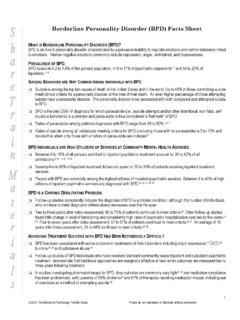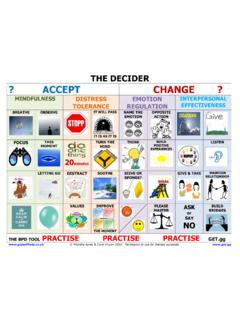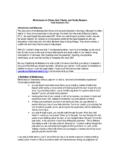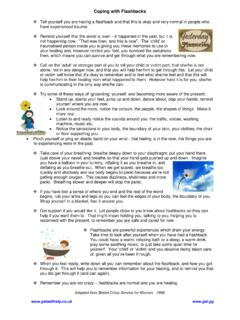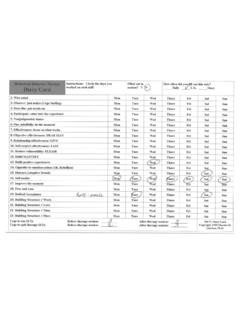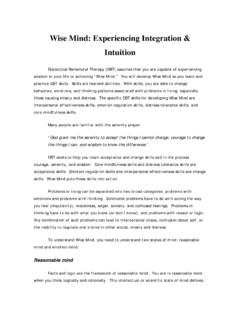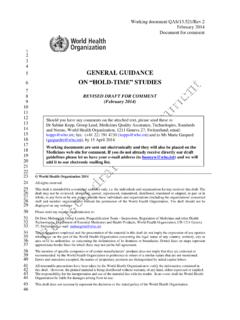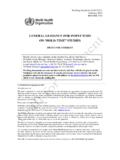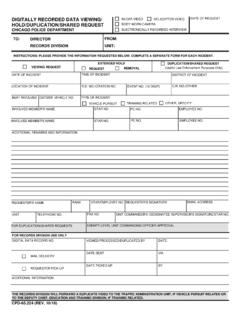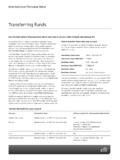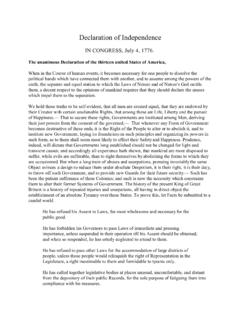Transcription of Observing, Describing, and Participating
1 Taking hold of Your Mind: What Skills: observing , describing , and Participating Core mindfulness skills are the foundation of all Dialectical Behavioral Therapy (DBT) skills training. The problems addressed by core mindfulness skills are knowing who you are, where you are going in your life, and the inability to control what goes on in your mind. These mindfulness skills are of two basic types What and How skills. The What skills refer to ways of practicing thinking or what you do to take control of your mind.
2 observing and describing are most useful when new behavior is being learned, there is some sort of problem, or a change is necessary. Mindfulness skills apply to emotional regulation, distress tolerance, and interpersonal effectiveness, too. observing observing is sensing or experiencing without describing or labeling the experience. It is noticing or attending to something. The benefit of this practice is that the mind becomes quiet. Eventually, you will be able to observe things without a running commentary of a talkative mind.
3 Preoccupation, rumination, distraction, and daydreaming are all examples of a talkative mind. Just notice the Experience. Notice without getting caught in the experience. Experience without reacting to your Allow yourself to experience with awareness, in the moment, whatever is happening. Pay attention to your experience. The information available to you includes bodily sensations, emotions, thoughts, and external phenomena. Mindfulness involves observation of constantly changing internal and external stimuli as they arise.
4 Rather than just notice what is happening and stay in the moment, the temptation is to get caught in the experience. Getting caught takes many forms like not being able to get out of bed although it is time to go, or to stop eating 1 Quotations from the skills training manual have been bolded. 1when you are full. Rumination and preoccupation are other forms of getting caught in your experience. Reacting to your experiences takes many forms too. Unpleasant emotions motivate you to terminate the experience or leave the situation.
5 Naturally, we react to pleasant events by wanting to prolong them. The challenge of observing is just to experience the moment without judging it good or bad, pleasant or unpleasant. The ability to step back from what is happening in the moment creates psychological space. This separation allows you to not get caught in or react to your experience. Without the psychological space, your reactions are automatic. Shame, guilt, anxiety, and depression often collapse your ability to create psychological space and cause automatic reactions (acting the way you feel).
6 Experiencing the moment without getting caught or reacting is a way to extinguish automatic responses. Psychological space creates room for mental flexibility and freedom of choice. Try to observe in a nonattached way. Whatever you observe happening in your mind is grist for the mill. Whatever happens in your mind is the nitty-gritty business of your life as it is being lived in the here-and-now. observing is the basis of self-awareness and can only happen in the here and now. When you observe your experience, you are more likely to have a feeling of self-agency, being in control of your thinking.
7 No matter what you are doing, you can just step back and observe. Step back a little, but stay within yourself the goal is to be slightly detached, not to shut down completely. Have a Teflon Mind, letting experiences, feelings, and thoughts come into your mind and slip right out. Teflon is a substance which creates a non-stick surface when applied to various materials. Teflon Mind is another way of saying let go of troubling thoughts that stick to your mind. The goal here is to stay in the present moment.
8 Many have found that this is a way to cope with intense feelings. Distressing events and emotions easily become stuck in consciousness. Teflon Mind is a way to attend to painful thoughts without getting stuck let them go. 2In mindfulness practice, one is instructed to experience exactly what is happening in the moment, without either pushing any of it away or grabbing onto it. The idea is to let thoughts, feelings, and sensations come and go, rise and fall away, without attempting to exert control (although one is in control and can stop the process at any time).
9 One important consequence of mindfulness is to realize that most thoughts, emotions, and sensations are transient and rise and fall like waves in the sea. Mindfulness is an example of the psychological technique of exposure. Exposure is a way or people who have fears or phobias overcome their aversion. By exposing themselves gradually to what they fear, they overcome their fear little by little. Mindfulness to naturally arising thoughts, feelings, and sensations works like exposure gradually helping you overcome the grip of certain thoughts, feelings, and sensations.
10 By observing thoughts, feelings, and sensations come and go, one learns that thoughts, feelings, and sensations do, indeed, come and go. This experience reduces the intensity of emotions. observing what goes on in your mind without reacting to the content of your thoughts extinguishes automatic avoidance and fear responses. The goal is to allow oneself to experience with awareness, in the moment whatever is happening, rather than leaving a situation or trying to terminate an emotion. Control your attention, but not what you see.
